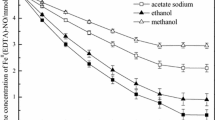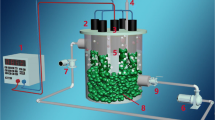Abstract
BioDeNO x process, which combines the advantages of the chemical absorption and biological reduction processes, is regarded as a promising candidate for NO removal from the flue gas. In the BioDeNO x , N2O was accumulated in the process of the biological reduction of FeII(EDTA)-NO. In this work, the pathway of the FeII(EDTA)-NO reduction was investigated and a mathematic model was developed to evaluate and predict the accumulation of N2O. Furthermore, parametric tests such as the effects of the C/N ratio (molar ratio of carbon/nitrogen), electron donor, and sulfite concentrations on N2O accumulation were investigated. Experimental results revealed that N2O accumulation was inhibited with a high C/N ratio (2.4), sufficient electron donor, and a low sulfite concentration. In addition, compared with the inorganic electron donor (FeII(EDTA)), the organic electron donor (glucose) was beneficial for microorganism metabolism and N2O accumulation inhibition. This work will provide significant insight into the inhibition of N2O accumulation during the operation of BioDeNO x and advance this novel process for the industrial application.






Similar content being viewed by others
References
Wang YY, Geng JJ, Guo G, Wang C, Liu SH (2011) N2O production in anaerobic/anoxic denitrifying phosphorus removal process: the effects of carbon sources shock. Chem Eng J 172:999–1007
Ravishankara AR, Daniel JS, Portmann RW (2009) Nitrous Oxide(N2O): the dominant ozone-depleting substance emitted in the 21st century. Science 326:123–125
Kampschreur MJ, Temmink H, Kleerebezem R, Jetten MSM, van Loosdrecht MCM (2009) Nitrous oxide emission during wastewater treatment. Water Res 43:4093–4103
Hwang S, Jang K, Jang H, Song JY, Bae W (2006) Factors affecting nitrous oxide production: a comparison of biological nitrogen removal processes with partial and complete nitrification. Biodegradation 17:19–29
Vonschulthess R, Kuhni M, Gujer W (1995) Release of nitric and nitrous oxides from denitrifying activated-sludge. Water Res 29:215–226
Thorn M, Sorensson F (1996) Variation of nitrous oxide formation in the denitrification basin in a wastewater treatment plant with nitrogen removal. Water Res 30:1543–1547
Vonschulthess R, Wild D, Gujer W (1994) Nitric and nitrous oxides from denitrifying activated-sludge at low-oxygen concentration. Water Sci Technol 30:123–132
Ritchie GA, Nicholas DJ (1972) Identification of the sources of nitrous oxide produced by oxidative and reductive processes in Nitrosomonas europaea. Biochem J 126:1181–1191
Zhang SH, Cai LL, Mi XH, Jiang JL, Li W (2008) NOx removal from simulated flue gas by chemical absorption-biological reduction integrated approach in a biofilter. Environ Sci Technol 42:3814–3820
Chen J, Dai QZ, Qian HF, Jiang YF, Chen JM (2013) Nitric oxide enhanced reduction in a rotating drum biofilter coupled with absorption by FeII(EDTA). J Chem Technol Biotechnol 88:579–584
van der Maas P, van de Sandt T, Klapwijk B, Lens P (2003) Biological reduction of nitric oxide in aqueous Fe(II)EDTA solutions. Biotechnol Prog 19:1323–1328
Zhang SH, Chen H, Xia YF, Liu N, Lu BH, Li W (2014) Current advances of integrated processes combining chemical absorption and biological reduction for NO x removal from flue gas. Appl Microbiol Biotechnol 98:8497–8512
van der Maas P, Manconi I, Klapwijk B, Lens P (2008) Nitric oxide reduction in BioDeNO x reactors: kinetics and mechanism. Biotechnol Bioeng 100:1099–1107
Dong XY, Zhang Y, Zhou JT, Chen MX, Wang XJ, Shi Z (2013) Fe(II)EDTA–NO reduction coupled with Fe(II)EDTA oxidation by a nitrate and Fe(III)-reducing bacterium. Bioresour Technol 138:339–344
Ottengraf SPP, Van Den Oever AHC (1983) Kinetics of organic compound removal from waste gases with a biological filter. Biotechnol Bioeng 25:3089–3102
Dincer AR, Kargi F (2000) Kinetics of sequential nitrification and denitrification processes. Enzyme Microb Technol 27:37–42
Okkerse WJH, Ottengraf SPP, Osinga-Kuipers B, Okkerse M (1999) Biomass accumulation and clogging in biotrickling filters for waste gas treatment. Evaluation of a dynamic model using dichloromethane as a model pollutant. Biotechnol Bioeng 63:418–430
Adouani N, Lendormi T, Limousy L, Sire O (2010) Effect of the carbon source on N2O emissions during biological denitrification. Resour Conserv Recy 54:299–302
Wu CF, Shimaoka T, Nakayama H, Komiya T (2015) Kinetics of nitrous oxide production by denitrification in municipal solid waste. Chemosphere 125:64–69
Ye RW, Averill BA, Tiedje JM (1994) Denitrification-production and consumption of nitric-oxide. Appl Environ Microbiol 60:1053–1058
Zumft WG (1997) Cell biology and molecular basis of denitrification. Microbiol Mol Biol Rev 61:533–616
Zhu RL, Wang SY, Li J, Wang K, Miao L, Ma B, Gong LX, Peng YZ (2013) Effect of influent C/N ratio on nitrogen removal using PHB as electron donor in a post-denitritation SBR. J Chem Technol Biotechnol 88:1834–1905
Itokawa H, Hanaki K, Matsuo T (1996) Nitrous oxide emission during nitrification and denitrification in a full-scale night soil treatment plant. Water Sci Technol 34:277–284
Itokawa H, Hanaki K, Matsuo T (2001) Nitrous oxide production in high-loading biological nitrogen removal process under low COD/N ratio condition. Water Res 35:657–664
Wu GX, Zhai XF, Jiang CG, Guan YT (2013) Effect of ammonium on nitrous oxide emission during denitrification with different electron donors. J Environ Sci (China) 25:1131–1138
Straub KLBM, Schink B, Widdel F (1996) Anaerobic, nitrate depending microbial oxidation of ferrous iron. Appl Environ Microbiol 62:1458–1460
Manconi I, van der Maas P, Lens PNL (2006) Effect of sulfur compounds on biological reduction of nitric oxide in aqueous Fe(II)EDTA2− solutions. Nitric Oxide 15:40–49
Hilton BL, Oleszkiewicz JA (2014) Sulfide-induced inhibition of anaerobic digestion. J Environ Eng 114:1377–1391
Jensen KM, Cox RP (1992) Effects of sulfide and low redox potential on the inhibition of nitrous-oxide reduction by acetylene in Pseudomonas-Nautica. FEMS Microbiol Lett 96:13–17
Acknowledgments
The research was supported by the National Key Research and Development Program of China (No 2016YFC0203700), the National Natural Science Foundation of China (No. 21277125) and Program for Changjiang Scholars and Innovative Research Team in University.
Author information
Authors and Affiliations
Corresponding author
Rights and permissions
About this article
Cite this article
Chen, J., Wang, J., Zheng, J. et al. Prediction and inhibition of the N2O accumulation in the BioDeNO x process for NO x removal from flue gas. Bioprocess Biosyst Eng 39, 1859–1865 (2016). https://doi.org/10.1007/s00449-016-1660-3
Received:
Accepted:
Published:
Issue Date:
DOI: https://doi.org/10.1007/s00449-016-1660-3




